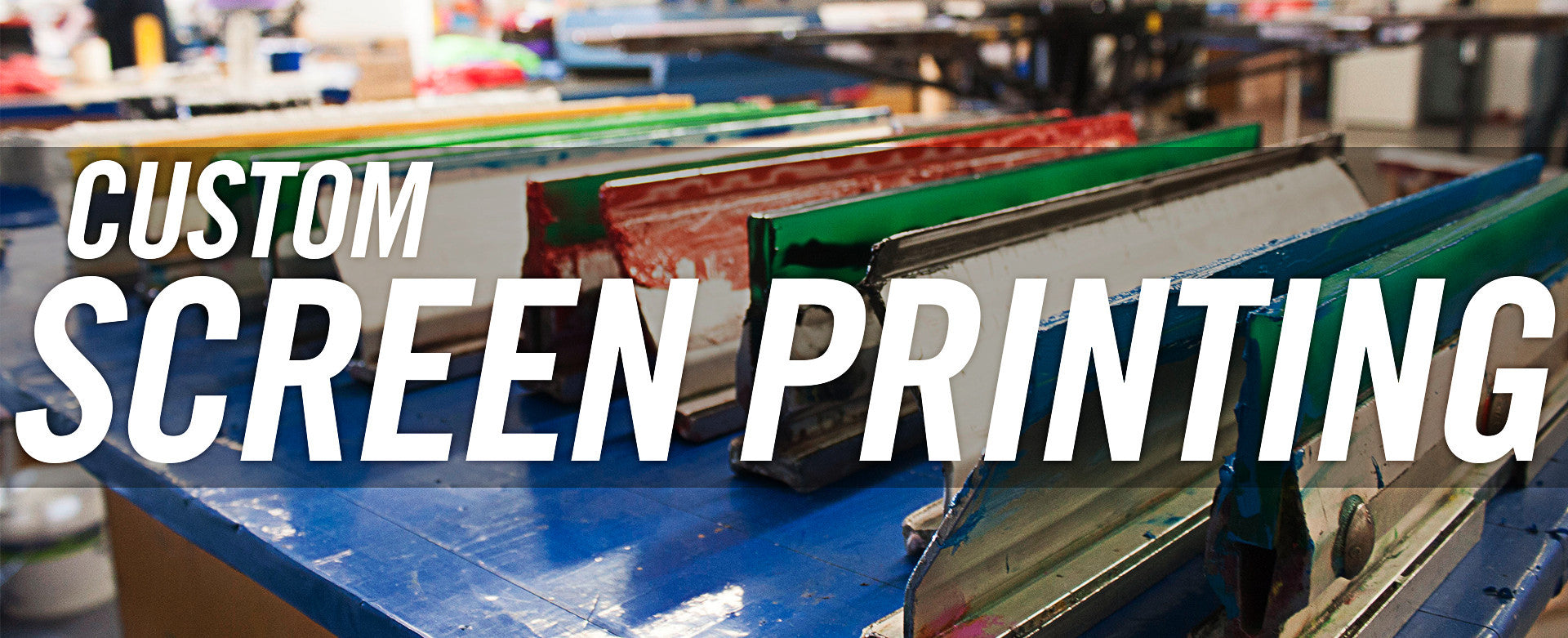High-End Silk Screen Printing for Premium Garments
Wiki Article
Understanding Silk Display Printing: Advice for Creating Stunning Designs
If you're looking to understand silk screen printing, you'll require even more than just enthusiasm. By the end, you'll be prepared to create sensational designs that mirror your distinct design.Recognizing the Basics of Silk Screen Printing
Silk screen printing, often called screen printing, is a flexible approach for transferring designs onto different products. You'll locate it's perfect for publishing on fabrics, paper, plastic, and extra. The procedure involves producing a stencil, or screen, that enables ink to go through just in specific areas, producing vivid and clean designs.To start, you'll need to prepare your artwork, guaranteeing it remains in an ideal style. screen printing kit. You'll coat your display with a light-sensitive solution and expose it to light as soon as you have actually got your design ready. This step produces a stencil of your layout on the screen
After washing out the unexposed emulsion, you're established to print. Align your display over your product, apply ink, and make use of a squeegee to press the ink via the screen. It's all about technique and perseverance, so do not hesitate to experiment and fine-tune your method as you go.
Essential Tools and Products You'll Need
To start with silk display printing, you'll require a couple of fundamental products like displays, mops, and ink. You can discover innovative equipment that improves your printing quality and effectiveness once you're comfortable. Let's discuss what you'll require to ensure your tasks achieve success from the beginning.Basic Silk Screen Products
Beginning on a silk display printing job calls for a couple of vital devices and materials to ensure your success. You'll need a silk screen structure, which holds the mesh that transfers your design. A squeegee is vital for pushing ink through the display onto your substrate. Do not forget the ink itself; select colors that suit your layout and the product you're printing on. A light source is essential for exposing your screen, in addition to emulsion to create your stencil. You'll additionally require an appropriate workspace, preferably one that's cost-free and well-lit from dirt. Lastly, stockpile on cleaning supplies to maintain your devices and maintain your screens in excellent condition. With these basics, you're prepared to dive right into your project!Advanced Printing Tools
When you prepare to take your silk screen printing to the next level, buying sophisticated printing tools can make a considerable difference. A high-quality screen printing press is necessary; search for a multi-color press that permits for precise registration and quicker production. You'll likewise intend to upgrade to an extra reliable direct exposure unit to guarantee your layouts are sharp and dynamic.Consider purchasing a reputable warmth resource, like a conveyor dryer, for also curing of inks. Don't forget specialized inks; water-based and discharge inks provide outstanding outcomes on numerous textiles. A good set of mops and emulsion scoop coater will simplify your procedure, giving your designs that specialist edge.
Preparing Your Art Work for Printing
Preparing your artwork for silk display printing is important to attaining dynamic, expert outcomes. Start by verifying your layout is in the ideal format-- vector files like.AI or.EPS job best. By doing this, your artwork keeps top quality at any dimension. Next off, check the shade setting; use CMYK for precise color depiction.When your data is all set, develop a different layer for each color in your layout. This'll make it less complicated during the printing process. Do not neglect to include enrollment marks to straighten colors appropriately.
Additionally, consider the mesh count of your screen; finer details may call for a greater mesh matter. Ultimately, save your artwork with a resolution of at the very least 300 DPI to guarantee crisp prints. By complying with these actions, you'll set on your own up for a successful printing experience and bring your designs to life perfectly.
The Display Printing Refine: Step-by-Step
Now that you've prepared your artwork, it's time to focus on the display printing process itself. You'll begin by preparing your display, ensuring it awaits the ink application. From there, you'll discover different printing techniques to attain the very best results for your project.Preparing Your Display
Getting your display prepared is a crucial step in the silk screen printing process. When dry, position your transparency on the display and utilize a light source to reveal the design. After direct exposure, wash out the unexposed solution, and you'll have your display prepared for printing.Printing Techniques Clarified
As soon as your display prepares, you can dive into the amazing procedure of printing. First, area your screen on your substratum-- whether it's fabric, paper, or one more material. Secure it to avoid any type of motion. Next off, put your ink onto one side of the display and make use of a squeegee to draw the ink throughout the style. Apply even press to ensure the ink permeates through the mesh. Lift the screen thoroughly to expose your print. If you're layering colors, allow each layer completely dry before using the next. Clean your display quickly to avoid ink from blocking the mesh and drying. With method, you'll grasp the subtleties of pressure and timing, which will certainly help you achieve crisp, vivid designs.Tips for Getting Vibrant Color Styles
While achieving vibrant colors in silk screen printing might seem tough, you can easily boost your designs with a couple of essential strategies. First, select top quality inks especially made for silk screen printing; they give better coloring and coverage. Blending inks appropriately can additionally improve vibrancy-- trying out ratios to locate the best blend that pops.
Last but not least, don't forget custom screen printing treating your prints appropriately. Appropriate warmth setting guarantees the shades bond with the material, preserving their vibrancy with time. By executing these strategies, you'll create spectacular, captivating styles that really shine.
Repairing Common Printing Problems
Even with dynamic colors in your designs, silk display printing can in some cases present difficulties. One common problem is ink bleeding, which often occurs when you make use of excessive ink or do not allow the previous layer completely dry totally. To prevent this, utilize a squeegee with simply the best pressure and ensure each layer is completely dry prior to including a lot more.If your design isn't lining up correctly, double-check your enrollment marks and make modifications to your displays. Tidy your displays extensively prior to starting your print run.
Last but not least, if the ink isn't sticking well to the textile, take into consideration the textile kind and the healing procedure. Ensure you're making use of the ideal ink and that you're curing it at the proper temperature. Repairing these typical concerns will assist you achieve sensational results.
Exploring With Results and strategies
Trying out with different methods and impacts can raise your silk display printing tasks to new heights. You can additionally play with textures-- making use of different squeegee methods or including products like brushes or sponges includes dimension to your prints.Take into consideration utilizing specialized inks, such as glow-in-the-dark or metallic, to give your layouts an unexpected twist. You may also check out stenciling, where you can reduce elaborate styles for stunning results.
Don't ignore substrate variations! Printing on fabrics, timber, or paper can produce different outcomes that enhance your project's feeling.
Ultimately, keep a journal of your experiments. Documenting your failures and successes will assist your future productions and aid you improve your design. Accept the process, and enjoy the journey of discovering what works best for you!
Frequently Asked Inquiries
Just how Do I Clean and Keep My Display Printing Equipment?
To clean and preserve your display printing equipment, on a regular basis scrub screens with an ideal cleaner, clean squeegees after use, and store whatever in a completely dry, dust-free setting. Keeping things clean warranties better prints and longer-lasting devices.
Can I Publish on Materials Besides Material?
Yes, you can print on materials apart from textile! Consider making use of paper, wood, or plastic. Just ensure your inks and displays work with those surface areas for the very best outcomes. Experiment and enjoy!What Is the Best Method to Store Screens and Inks?
To store inks and displays successfully, maintain displays upright in an amazing, dry location, and cover them to avoid dust. Shop inks in airtight containers, far from direct sunlight, to maintain their quality and consistency.How Do I Pick the Right Mesh Matter for My Project?
Choosing the ideal mesh matter depends upon your layout's information and ink kind. For fine information, go higher, like 200 mesh (screen printing kit). For vibrant layouts, a reduced count, around 110, functions ideal. Experiment to discover your suitable suit.What Are the Ecological Influences of Silk Screen Printing?
Silk screen printing can have environmental influences, like chemical waste and water usage. You can reduce these by utilizing eco-friendly inks, recycling materials, and effectively throwing away chemicals to reduce your project's eco-friendly impact.Silk screen printing, commonly called screen printing, is a flexible approach for transferring layouts onto various materials. Align your display over your product, apply ink, and utilize a squeegee to push the ink through the screen.To get started with silk screen printing, you'll need a few standard products like displays, squeegees, and ink.When you're ready to take your silk screen printing to the next degree, spending in innovative printing devices can make a significant distinction.Getting your display ready is a critical step in the silk display printing procedure.
Report this wiki page